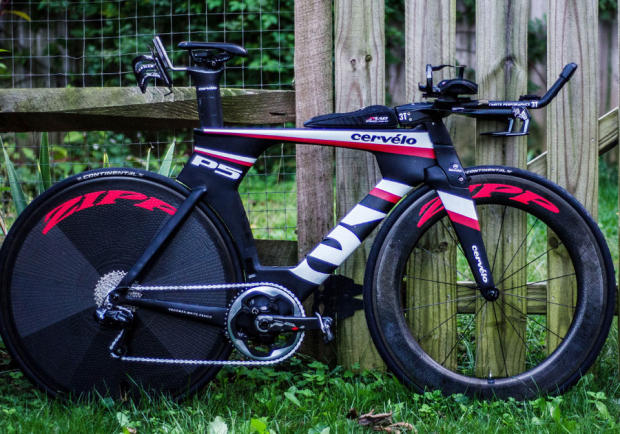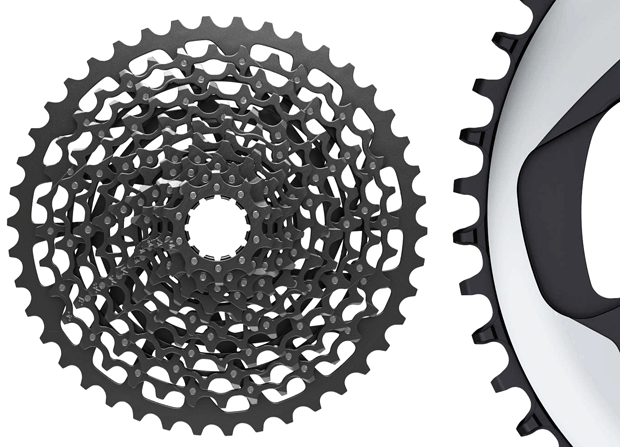1x Best Practices
By the term 1x we mean a drivetrain consisting of a single chain ring in front. In 6 years the manufacturer SRAM repurposed a pair of shelved technologies, brilliantly displayed their relevancy, and transformed the landscape of cycling.
This Chicago-based component maker does one thing particularly well: absorbing strategic acquisitions. A case in point is Sachs Bicycle Components of Germany. SRAM’s 1x program was mostly a German idea, and a forgotten derailleur project for a downhill bike combined with the chain ring profile from a bike designed with a planetary gear hub (such as you would fine on a European city commuter) came together to form the straight parallelogram clutch rear derailleur and X-Sync chain ring. This is the fruit of SRAM's German operation in Schweinfurt, ex the Sachs Bicycle factory.
Even when the MTB version of 1x was launched SRAM must have doubted its reach. Yes, SRAM had convinced much of the cycling world to move from 3 chain rings back to 2 but then, contrary to any rational prediction, back to 1.
We live in a world where much of cycling has embraced the 1x platform. This is a dominant drive train platform in cyclocross, fat, plus, gravel and much of MTB. SRAM is not the only component maker offering 1x but it is the company most closely associated with it.
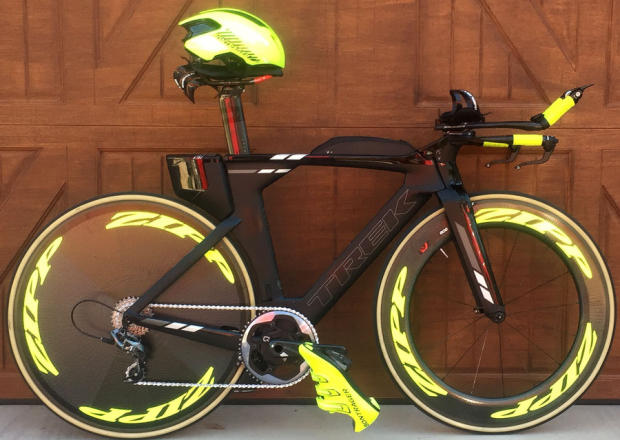
I’m riding 1x (on my plus bike) and I’m a convert. I’ll be switching my gravel bike to 1x. But what about 1x for tri? Is this a bridge too far? Not for some users like the one above, who sports a 52t X-Sync ring above along with the Force 1x RD outfitted with Ceramic Speed narrow-wide pulleys.
Over the last few weeks we’ve published photo essays on users who’re riding 1x for tri. These users tend to ride flatter courses; are running predominantly 11-28 or 11-32 cassettes; which means not much climbing, and nothing very steep.
What about a wider audience? Those who’ll ride more variable terrain? For this to happen the tech imperatives grow. What about electronic? And prognosis for advancement? Compatibility with makers of other components? I spoke to SRAM at length last week. Below is a set of best practices for 1x mostly based on SRAM’s advice but somewhat colored by the experience of end users.
First, let’s talk about how ready the tri market is for this. I polled Slowtwitchers last week. Twelve percent of 620 respondents are already riding 1x. Another 11 percent say they’re moving over imminently. Just under half say they’re not moving from 2x under any circumstance. The remaining 30 percent say they are persuadable. What would make them change?
Sixteen percent want electronic as a condition of changing to 1x. Twenty-five percent are looking for some sort of gearing accommodation. We’ll talk about gearing below – I think that problem has been solved (just not by SRAM).
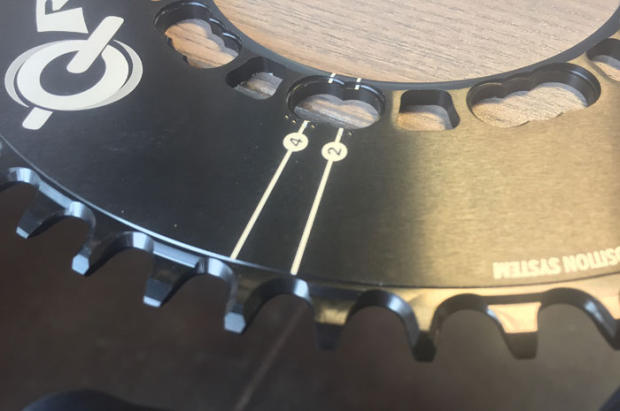
If you simply look at how triathlete end users are now riding their 1x rigs they obviously consider the chain ring the preeminent piece. SRAM’s branded technology is called X-Sync, it’s known generically as “narrow-wide” and it’s a tooth profile that grabs the chain and makes it unlikely to derail. Above is a narrow-wide ring, this one is made by Rotor. I’m using this image because it's so clear that the teeth alternate in their shape – every other tooth, every second tooth, is repeated. A chain has inner and outer plates, and this kind of chain ring snugly fits up inside every link.
To me the first round of questions were: Is the chain ring really the heart of the system? Is narrow-wide just as good from manufacturer to manufacturer? And are there chains that work specifically well for this chain ring motif?
Is the Narrow-wide Ring All You Need?
One thing that really chaps the hide of those at SRAM is the notion that the ring is all you need to make a 1x system work. As regards 1x, SRAM’s animating principle is crisp shifting and the chain staying on the ring under all conditions. It is adamant that, no, it is not simply tension in the derailleur cage that is the key to keeping the chain on the X-Sync ring. It is the clutch in the derailleur; the tooth profile of the derailleur pulleys; and it is the use of its straight (rather than the slant) parallelogram. In short, SRAM doesn’t stipulate at all that the X-Sync ring is the heart of the system, because to do so diminishes the value of a rear derailleur, the function of which SRAM considers mandatory to the system.
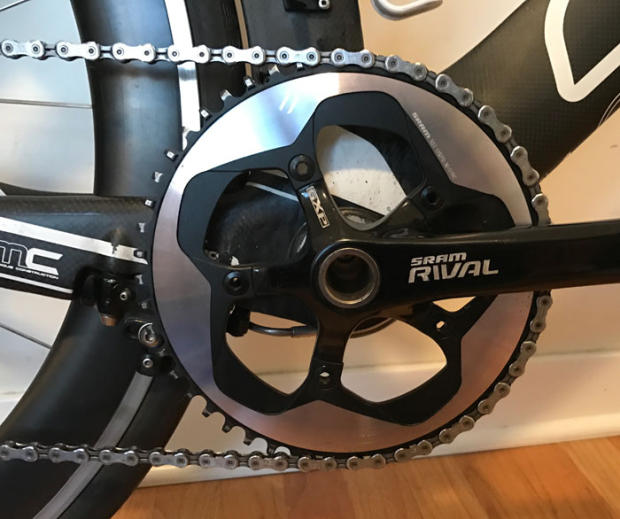
SRAM complained to me that of the six bikes in our first two 1x user photo essays none had a clutch RD. I explained that this wasn’t an editorial choice; these were the first six bikes users sent in to me (the 7th was the charm, and the Force1 RD is on the bike in the image highest above). The fact that these other bikes did not have clutch RDs was not a debasement of clutch-RD tech, rather a reflection of what these first six users are (wisely or unwisely) riding.
But I take SRAM’s point and I think this post from a Slowtwitcher expresses what SRAM wants to impart to 1x users: "I was an early adopter with 1x on my CX bike… 4 years ago. For the first two seasons and many races… I didn't drop a chain once while using a standard RD. In my 3rd year of use, I had a couple of drops. At the beginning of this season, it was dropping like once per ride, even on the road!… Same bike, same wheel, same cassette size, same RD, same chain length.
"As an experiment, I 'borrowed' an XO clutch RD from my MTB to see if this would help with chain drops. I did a couple of rough off-road rides and it stayed on, so I rolled with it. I managed to use the old ring for the rest of the season without a drop (CX racing too)… I will eventually put clutch RD on all my 1x bikes.”
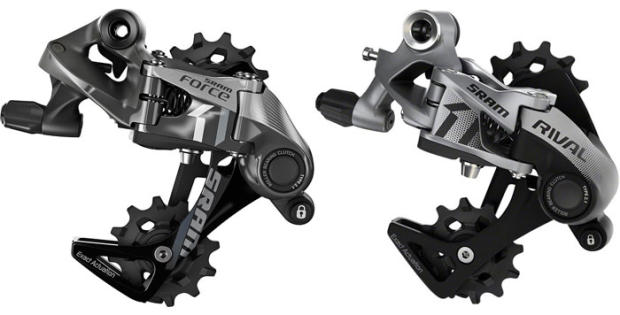
I think the takeaway is that an X-Sync ring might be fine with a standard RD in the beginning, but if the chain wears; if the ring wears; if the chain is not the precise correct length; if anything is unoptimized in that system, your chance of a derailment becomes much more likely without the clutch RD (SRAM's Force1 RD is above left, the Rival is next to it). Such is the case with Jeremy Rielley’s Felt DA, the SRAM 1x chain ring on the crank above. He’s currently running a SRAM Red short cage RD with SLF Motion Pulleys. It has been working okay with his 11-25 cassette. But he wants to move to 11-32 and is going to either invest in a Wolftooth Roadlink (see below) or a new RD (SRAM’s counsel would be the 1x RD!).
Chain length
SRAM guys say chain length is critical, and here is the latest chain guide recommendation. I and many of us learned, decades ago, to size chains while in the small-small gear. If with 1x a chain-too-long is more the concern with 1x than a chain-too-short, intuitively that argues for the chain size to be determined while in the small cog. But SRAM says otherwise and I have learned to trust SRAM’s judgment on how to adjust its components after trying to adjust its yaw FD based on my own intuition.
Interestingly, SRAM recommends adjusting the chain length the way you’d adjust it for a 2x if you’re using a 2x RD on a 1x system. Mind, they don’t want you to use a 2x RD in a 1x shift system. But they recognize it’s being done anyway.
Finally, SRAM says that if you use multiple cassettes, changing per the profile of the course, size your chain for the smallest cassette. It’s important that your chain not be too long! That’s really the case if you use a 2x RD (against SRAM’s advice). This again causes me to ask why the chain is not sized based on the small cog if a chain-too-long is the concern (I’m sorry, SRAM, I stipulate to your wisdom, but I still don’t understand).
Non-SRAM Narrow-wide Rings
At a minimum narrow-wide (the technology SRAMS X-Sync rings use) chain rings are made by Wolf Tooth, 1 up, Rotor, Race Face, AbsoluteBLACK and Osymetric, as well as all the companies I don’t know about that’re making them. You can see Race Face’s immediately below.
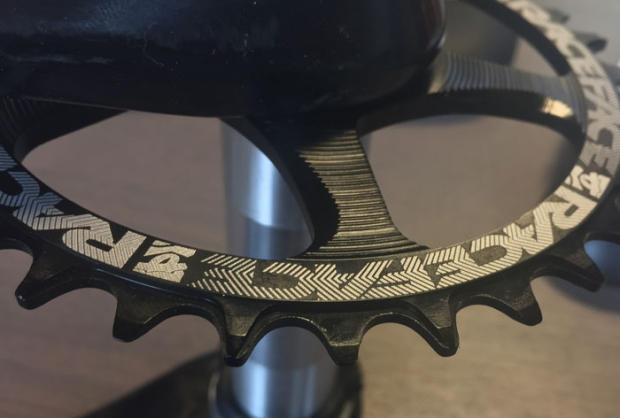
Which of these rings does SRAM say is a nice match with the rest of its 1x tech? While there are no moving parts to a chain ring (except for the whole ring), there are a number of moving parts to this question. Which companies violate SRAM’s patent? If these companies engineer around the patent, are they making rings that hold the chain in place just as well? Which companies have licensed X-Sync from SRAM? Which will license from SRAM? Which are in current negotiations? Is it in SRAM’s interest to endorse a ring from another brand before that license deal has been struck? (Probably not.) The answer to these questions is (as of now), I don’t know.
Why would you want to buy a ring other than SRAM’s X-Sync? Two reasons. First, if you are infatuated with the notion of direct-mount, AbsoluteBLACK is the obvious ring here. Why bolt the ring onto something (a spider) that gets bolted onto something else (the crank) when you can omit the spider and bolt directly to the crank? Fair point. Except if the ring isn’t as good as the X-Sync ring at performing the 1x function. Is it as good? I don’t know.
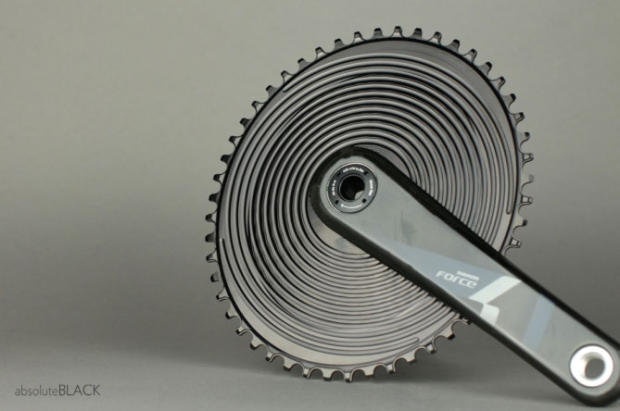
There is another issue, which is, what if you’re also infatuated with the notion of non-round rings? There is no oval X-Sync ring. That leaves Rotor, Osymetric and AbsoluteBLACK, the last of which is direct mount (shown above). Again, we come to function. Does AbsoluteBLACK's ring allow you to ride a desirable torque profile? Don’t know. Just note that changing the orientation of the ring around the face of the pedal circle is Rotor’s patent (it’s the only oval ring that offers this). Is this important? Here’s my rhetorical question to you: Is your saddle setback the same on both your tri and road bike? Do you ride knee-over-pedal-spindle on your tri bike? (I hope not!) My point: Is your torque profile the same whether you ride road or tri and, if not, which torque profile are the other rings optimized for: road or tri?
Enough about that. We’ll talk about oval rings another time.
Larger Cassettes
As we see, a lot of Slowtwitchers are riding their 1x rigs using 11-25 up to 11-32 in the back. On paper that meets the requirement of standard, 2x, medium or long cage RDs. I’m sidestepping the question of whether you should ride standard RDs, just that your cassette (up to 32t) does not exceed the technical limitations of standard RDs if your RD has a long enough cage.
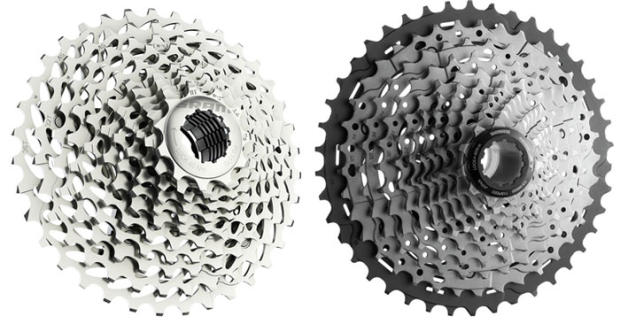
The last time I raced the Wildflower Triathlon long course (may it rest in peace; may it rise again!) I finally nailed the gearing. That course had 6 miles out of 56 of ascent between 7 and 9 percent. Bear in mind I’m trying to hoist my weight up these hills, not riding below 75rpm, not riding above 300 watts. I’m 170 pounds. You do the math. I needed a 34×27. But on the backside there were miles and miles of a pedaling descent, 2 or 3 percent. I needed every bit and more of that 50×11.
A 50×11 is 120 gear inches, and a 34×27 is 33 gear inches. That’s the range. SRAM makes an 11-36 (above left), and if you pair that with the single 50t ring what do you have at the low end? A 50×36 is 36.6 gear inches. That’s low enough for those who would race on a 34×25. It’s not quite a low enough gear for me.
SRAM makes an 11-42, in the Apex line, kind of heavy, kind of down-spec, but it’s available. Shimano makes a higher-end 11-42 that’s perfectly compatible with the rest of SRAM’s 1x drivetrain, and it makes an 11-40 as well (above right). The rollout of that 50×42 is short, about 31 gear inches. In fact, you could move up to a 53t front ring and have the exact same small gear as a 34×27. For those who want a cassette for all occasions, these Shimano cassettes are the way to go.
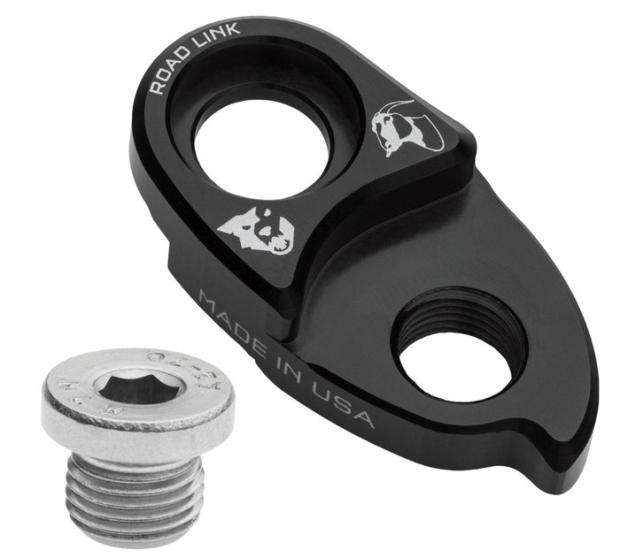
If you do decide in favor of a 11-36, 11-40, or 11-42, in my opinion you really must use a clutch RD, not to keep the chain on the ring as much as no other RD is made for cassettes this wide-ratio. Yes, Wolf Tooth makes an adapter (above) that lowers your 2x RD, theoretically enabling a non-conforming derailleur to conform. Does this work? I don’t know. I don’t speak for SRAM, but if I can channel my inner SRAM, using this Wolf Tooth device on a 2x RD is jury-rigging a system that is already a jury-rig.
Chains
SRAM will not give me a list of chains that conform to its 1x drivetrain. But it isn’t saying that other chains (Shimano, Wippermann, KMC, and the high-performance derivatives like PremierBike and Ceramic Speed UFO, etc.) won’t work. SRAM simply says that it only tests its 1x drivetrain against its own chain, so it has insufficient data to opine on other chains.
Electronic Shifting
There remains, really, one compelling temptation to use an RD not made for 1x use on a 1x bike: electronic shifting. We have a number of Slowtwitchers who’re using both Shimano Di2 and SRAM eTap on their 1x rigs. Does this work? These systems are being used, so they must “work” (assuming the chain stays aboard the chain ring). It seems to me there are critical imperatives here. First, the RD can’t be used beyond its capacity, that is, the slant parallelogram designs of today's 2x derailleurs want to work with a cassette that does not expand above a given max tooth-size. Currently, with everybody’s longest cage 2x electronic derailleur, I think that’s probably 32 teeth. (We’ll get to electronic RD hacks that make these RDs work for 1x in a minute.)
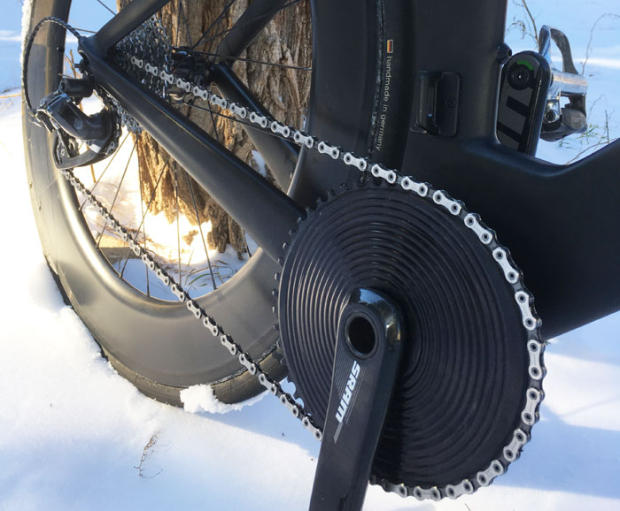
Second, the chain length must be exact and not a link longer. Third, of course you must use an X-Sync or other properly functioning narrow-wide ring. Fourth, you must keep your system clean and lubed and you’ll have to change consumables (chain, chain ring, cassette) sooner than you would if you had a clutch RD.
What’s on the Horizon?
SRAM is not making an electronic 1x system in the immediate future, per their conversation with me last week. They are also not making a 10-tooth 1st-position cog for road beyond what they already have that can be used for CX (which means it could theoretically be used for road). Right now the 10-tooth cog goes on a 10-42 11sp cassette, and a 10-50 12sp cassette. There are no plans to make this, or to make wheels built originally with the XD driver required to handle a 10-tooth cog, for road (you can place an XD driver aftermarket into Zipp’s aero wheels).
That established, if 11-42 borders on gear overkill 10-42 certainly would be. Now, 10-32, that might be nice. Still, no plans for that.
I felt, when 1x was intro’d a couple of years ago, that it would be a hard slog in tri unless SRAM found a way to give all triathletes, regardless of where they live or race, tri-appropriate gearing. My opinion notwithstanding, 1x has gained a following among triathlon, but this following is regional. It’s terrain-limited. Ironically, Shimano making relatively high-end 11-40 and 11-42 11-speed cassettes gives users racing in any terrain permission to go 1x, even while using SRAM products for the rest of the drive train. These Shimano cassettes mean 1x is now ready for use in triathlon by any racer of any ability in any terrain.
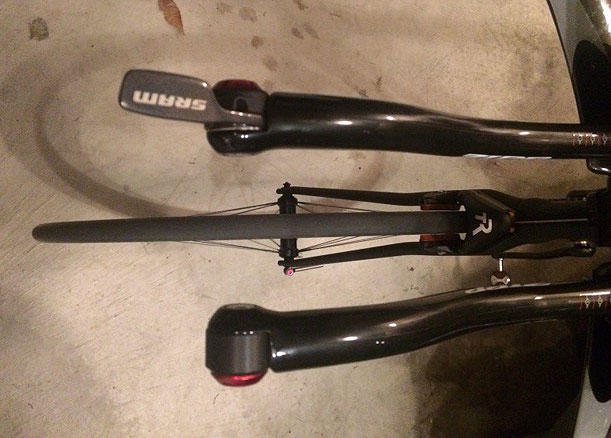
I would like to see SRAM consider making two new products. First, a higher-end 11sp cassette in 11-40 or 11-42. Second, SRAM or somebody ought to make a shift system that looks better than an aerobar that has suffered an amputation (just above). I actually like the idea of SRAM’s old, ancient twist shifters, one of which would function the other just a dummy, rather than the orphaned paddle shifter we now see.
And finally, I’ve spent almost no time on the other company that makes clutch RDs and 1x systems: Shimano. This company has already made electronic 1x systems, for MTB. At least a handful, if not a fair number, of top cyclocrossers have hacked their way onto electronic 1x. I love reading CX Magazine’s mechanical makeovers and more than a year ago it wrote of hacking electronic road RDs made into clutch derailleurs, and Shimano’s electronic MTB derailleurs driven by electronic road actuators.
This isn’t the end of our discussion on where 1x is going in tri, nor even the beginning of the end. It is (in a famous turn of phrase) the end of the beginning.



